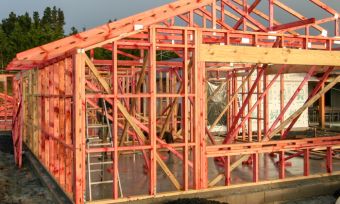Between the time you inspect a property and make an offer and the time you settle and it becomes yours, there are a number of potential issues that can come up, and problems that might need to be solved, whether these are structural or financial issues.
From building and pest inspections through to searches relating to the property and its title, a house inspection checklist can help you keep track of what you’ll need to do. We’ve seperated ours into two lists: pre-purchase inspections and land and title searches.
Pre-purchase checklist
- Personal inspection
- Building inspection
- LIM report
- Pest inspection
- Surveyor’s report
- Swimming pool inspection
- Pre-settlement inspection
Land and title search checklist
- Title search
- Registered plan search
- Bankruptcy search
- Council zoning (town planning) search
- Body corporate records search
What pre-purchase inspections will you need to do?
From casting your own eye over the house or apartment you plan to buy, to having professionals inspect it for potential defects, a thorough pre-purchase inspection will give you a good idea of what physical shape the property is in.
1. Personal inspection
When a property is for sale, there will typically be an inspection, during which prospective buyers can walk through to get a sense of the space, its layout and possible defects. If possible, it can be worth attending multiple inspections, and even bringing a friend or other trusted person along to act as a fresh set of eyes and spot any defects that you might not.
When inspecting a property yourself, it is also important to consider factors such as the overall character of the neighbourhood: whether there are any major construction projects nearby (ongoing or planned), and whether the house is close to facilities and amenities that are important to you, such as public transport, schools and parks.
In terms of the property, you may consider factors such as noise and natural light, and check light switches and door hinges to make sure they are all in good order. It’s also a good idea to check the taps and shower, to see what the water pressure is like. And, also, check in corners and cupboards to see if you can spot any signs of mould.
When inspecting, you should consider whether the property has sufficient car parking for your needs. You can research the cost of insurance (house and car) in the area you’re planning to buy relative to your current property, and if you’re buying an apartment, it could be a good idea to check the unit ownership costs.
2. Building inspection
While it is important for you to visually assess a property yourself when inspecting it, this alone may not be enough to ascertain any potential structural defects or concerns. For this reason, it is important to enlist a qualified building inspector to conduct a pre-purchase assessment of the property. A building inspector will typically consider factors such as:
- Plumbing
- Doors and windows
- Roofing, gutters and downpipes
- In-roof and under-floor crawl spaces
- Fences and retaining walls
- Garages, carports and garden sheds
- Stairs, floorboards and structural support beams
- Rising damp
- Water drainage on the property
- The presence of asbestos
A building inspection report should highlight any major defects or issues that need to be rectified. Some sellers may even obtain a building report when putting their property on the market, and may provide it by request.
If a building report brings to light any issues that need rectifying, you may be able to negotiate a lower price with the seller in order to save money for repairs down the track.
3. LIM report
A property’s LIM report is prepared by its local council. It’s a summary of all the current property information held by the council on the day the LIM was produced. In short, everything the council knows about the property and the land it stands on.
What does it cover?
A LIM includes information on some or all of the following:
- Stormwater or sewage drains
- Any Heritage New Zealand protection
- Special land features such as erosion or flooding
- Any rates owing on the land
- Permits, building consents or requisitions, and other certificates previously issued by the local council or building consent authority
- Any notices to the council given by any network utility operator under the Building Act
- Zoning – how the land may be used and any conditions that apply
- Any notices to the council by any statutory organisation that has the power to classify land or buildings for any purpose
- Any other information that the council thinks is relevant
As you can see from the information above, a LIM isn’t about the condition of the property (that’s what a building inspection is for) but, rather, everything that the council knows, and you should know, about the property as a whole. There’s plenty of information that can be unearthed, which could impact the desirability of the home. Such as:
- Is your backyard going to erode and fall into the ocean over the next few decades?
- Does the yard turn into a swimming pool every time it rains?
- Is the large tree in the yard (blocking out all that afternoon sun) protected, and unable to be cut down?
- If the rates are much higher than you were expecting, or if the current owner has outstanding rates bills
- Have there been extensive renovations completed on the property, but no building consent given for those renovations? If so, you could face the cost of getting them ticked off, or worse, removing them
You can get a LIM report from the local council of the property you are interested in purchasing. It should be as easy as going on to the council’s website and filling out an application.
Often, property vendors provide LIM reports for potential purchases to study. However, unless the LIM report is bang up to date, it’s worth getting your hands on an up-to-date copy. A LIM that’s even 12 months old might not contain crucial new information that could affect your decision to purchase a property.
If you’ve any doubts or questions about a home’s LIM report, your lawyer or conveyer should be able to help.
→ Related article: What Is a LIM report and Do I Need One?
4. Pest inspection
A pest inspection is often done in tandem with a building inspection and is a visual inspection undertaken by a licensed professional to identify any presence of pests on the property. A pest inspector may be able to detect evidence of a current or past infestation of pests, and should assess any damage that they may have done to the property. A pest inspector can make recommendations or suggest techniques to put in place to manage a pest problem, and how to prevent a future one.
5. Surveyor’s report
A surveyor’s report can give you a report showing exactly where the boundaries of your property are, and alert you to any blockages. This can be especially useful to have if any future disputes arise with neighbours about the boundaries of your property.
6. Swimming pool inspection
It is important to make sure that a property you plan to purchase is both compliant with local regulations, and structurally sound.
7. Pre-settlement inspection
The final inspection or pre-purchase inspection is one that you do in person just before settlement – often on settlement day or two to three days before. This is actually the last step, after all your other inspections and searches are complete. It is your last chance to check that everything on the property is in the condition you required when you signed the contract.
For example, is the home vacant? Have all the previous owner’s belongings and rubbish been removed? If the previous owner had a tenant who was reluctant to leave, did they do any damage on their way out?
Have all the conditions of the contract been fulfilled, such as cleaning or painting? Do all the fixtures and fittings work (e.g. dishwasher, air-conditioner)? Have the gardens become overgrown and abandoned since you agreed to purchase the property?
If any of the conditions of the contract have not been met, or there is a major issue with the property, then the seller will be in breach of the contract and you as the buyer should have the right to delay settlement until the issue is fixed.
What land and search titles will you need to do?
While properties can have obvious structural defects, there can also be various legal ones that are not apparent to the eye, and may only come to light when a lawyer or conveyancer undertakes searches related to the land and its title. Many of these searches can be undertaken by a conveyancing specialist acting on your behalf, but it is still important to know about what they can entail.
1. Title search
The title search gives you the correct address of the property you are buying, confirms that the seller is currently the true owner, and provides details of any encumbrances on the property. These can include easements granted to local councils to allow gas, water, or sewerage to flow through the property. They can also be restrictive covenants, an example of which might be a stipulation that all the properties in an estate have to stay looking the same on the outside, so you can’t renovate or change external elements.
2. Land record search
A land record search allows you to search for and purchase online property records such as a title, survey plan or other instrument. A land record search can also provide you with a property boundary map.
3. Bankruptcy search
If the seller of a property is a registered bankrupt, they may not have the legal right to sell it, which can have implications for the sale. A bankruptcy search can bring up any possible red flags.
4. Council development and main roads search
A council development search will show whether your local council may have approved the development of a huge block of apartments in your neighbourhood, or if a shopping centre will be built near your new home over the next few years. For example, for those living in Tāmaki Makaurau, the Auckland Unitary Plan is a vital reference point for areas of future development.
Likewise, on a grander scale, checking the Australia New Zealand Infrastructure Pipeline can give you an idea of any major projects that could be happening in your area.
5. Body corporate records search
For an apartment, unit or townhouse, it is worthwhile to obtain a copy of the last few years’ worth of annual general meeting minutes for the owners corporation; financial details of the administrative and sinking funds; and details about problems previously repaired (or not), such as any issues with water ingress, plumbing, drainage, fencing and driveways. You may want to know, for example, if there are any owners in the complex who are behind on their body corporate levy payments, or who are involved in some kind of dispute and are refusing to pay.
What if your property doesn’t pass an inspection?
Most property inspections are not a pass–fail matter. Pre-purchase checks are important though, and will give you valuable insights and information to consider before and after buying. The report you obtain from a building and pest inspection, for example, can let you know in advance what to expect from a property, helping you decide whether or not you really want to buy it.
Some pre-purchase inspections may reveal things that are deal-breakers for you. For example, if the cost of repairs needed is more than the property is worth to you, you may not want to purchase it after all.
A contract of sale for a property can be made conditional on the results of a building and pest inspection, and if you are unhappy, you may wish to back out of the sale, or ask for a reduction in the sale price to take into account the money you’ll spend fixing defects.
About the reviewer of this page
This report was reviewed by Canstar Content Producer, Caitlin Bingham. Caitlin is an experienced writer whose passion for creativity led her to study communication and journalism. She began her career freelancing as a content writer, before joining the Canstar team.
Enjoy reading this article?
You can like us on Facebook and get social, or sign up to receive more news like this straight to your inbox.
By subscribing you agree to the Canstar Privacy Policy





Share this article